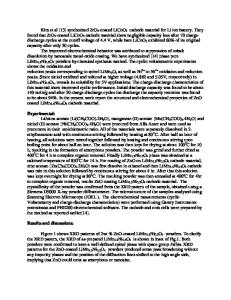Effect of K/Zr co-doping on the elevated electrochemical performance of Na 3 V 2 (PO 4 ) 3 /C cathode material for sodiu
- PDF / 3,756,633 Bytes
- 10 Pages / 595.276 x 790.866 pts Page_size
- 30 Downloads / 289 Views
ORIGINAL PAPER
Effect of K/Zr co-doping on the elevated electrochemical performance of Na3V2(PO4)3/C cathode material for sodium ion batteries Jiahao Li 1 & Jun Cheng 2,3 & Yanjun Chen 1,2 & Chao Wang 1,2 & Li Guo 2 Received: 1 April 2020 / Revised: 27 August 2020 / Accepted: 21 September 2020 # Springer-Verlag GmbH Germany, part of Springer Nature 2020
Abstract The Na3V2(PO4)3 (NVP) and its binary-doped Na2.96K0.04V2-xZr(3/4)x(PO4)3/C are prepared by a facile solid-phase method. The crystal structure, morphological characteristics, and electrochemical properties are analyzed by XRD, XPS, SEM, and electrochemical tests. The results reveal that K+ and Zr4+ have been successfully doped into NVP system without damaging the original structure. The co-doping strategy can broaden the channels of Na+ migration to facilitate the ionic conductivities. Meanwhile, it is beneficial to stabilizing the crystal structure effectively by introducing the K+ and Zr4+ with larger ionic radius. All the electrochemical properties of co-doped system are better than that of NVP, resulting from the lager channel for Na+ diffusion and enhanced intrinsic electrical conductivities by co-doping. Notably, Na2.96K0.04V1.93Zr0.0525(PO4)3/C exhibits the best electrochemical performance. It delivers a high discharge capacity of 107.3 mAh g−1 at 0.1 C; it remains 92.3 mAh g−1 after 400 cycles at 2 C, corresponding to the capacity retention of 92.02%; it still maintains 100.0 mAh g−1 even at 10 C rate. Keywords Sodium ion battery . Cathode material . Sodium vanadium phosphate . Co-doping
Introduction Lithium-ion batteries (LIBs) have attracted significant interest as the power sources of numerous portable consumer electronics due to their high safety, high energy density (both volumetric and gravimetric), long lifetime, wide operating temperature range, and environmental friendliness [1, 2]. However, Jiahao Li and Jun Cheng contributed equally to this work. Electronic supplementary material The online version of this article (https://doi.org/10.1007/s11581-020-03791-3) contains supplementary material, which is available to authorized users. * Yanjun Chen [email protected] * Chao Wang [email protected] 1
School of Materials Science and Engineering, North University of China, Taiyuan, China
2
Advanced Energy Materials and Systems Institute, North University of China, Taiyuan, China
3
School of Chemical Engineering and Technology, North University of China, Taiyuan, China
LIBs cannot meet the ever-increasing marketable demands due to the booming cost and limited availability of lithium reserves [3–6]. It is necessary and significant to develop alternative with high-performance to replace the LIBs. Recently, sodium-ion batteries (SIBs) has been a research hotspot in the fields of energy storage and conversion. Sodium has similar physical and chemical properties with lithium [7, 8], and the abundance is 430 times of lithium resources. Nevertheless, the larger radius of Na+ is considered to be a restriction because it makes the de-intercalation
Data Loading...










